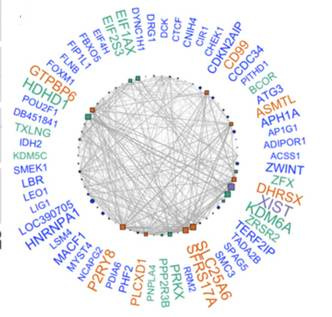“The Athletic Gender Gap Revisited” was really Chapter 1, even if not so labeled. so this is the correct order. Also, please don't imagine these are actually book chapters – this is just a way to keep track here.
Senator Marsha Blackburn thinks this is a dumb question. Supreme Court Justice Ketanji Brown Jackson doesn't. So who knows more?
Ms. Blackburn didn't give her own answer, but I'll wager she's certain there are exactly two sexes (as the Trump regime has now decreed; the same way some politicians would like to decree that π = 3). They know this, with certainty, from high school biology: women have XX chromosomes and men XY, and that's science.
Maybe they were ill on the day aneuploidies were discussed.
Among the combinations of sex-related chromosomes known are XO, XXX, XXY, XYY, XXYY, XXXY, and XXXXY. Most (but not all) of these have male phenotypes, including genitals, if even one Y chromosome is present. But there was another lesson the next day: not all cells in one human body necessarily have the same chromosomes. This is called mosaicism.
For example, the 45,X/46,XY mosaicism (incidence 1 in 15,000) results in male genitalia most of the time (~95%), but female ones occasionally, and mixtures in others. Similarly XXXXY individuals (46XX, 47XXY mosaic) may exhibit either male or female phenotypes, or both, and either gender identity may be associated with either phenotype. Though most of these are rare (incidence of the last is ~1/100,000), “rare” doesn't equal zero, and disrespecting any person for their genetics might not seem so much like “no big deal” if that person were Marsha Jackson instead of an anonymous citizen who can't defend themselves on national TV.
And the word “intersex” has yet to even appear.
But the two-sex contingent have a new island to jump to: just look at the reproductive system, fergawdsake! Women are “people who menstruate” (so obvious – just ask JK Rowling).
Or maybe not.
Defining a female human by menstruation invites a small 800-pound gorilla in the room – now what did happen to those pre-puberty girls? But, imagining for the sake of argument that one's sex needn't be known or mentioned until then, consider that the incidence of primary amenorrhea is given as anywhere between less than 0.1% and less than 1%. Up to 2 – 5% of adolescent girls may present with it at clinics. Once again: if you were one of them – it's okay to just discard you from consideration, right? You don't matter?
Two observations are important here: 1) even at the lowest limit, the number of affected people is hundreds of thousands in the U.S. alone; and 2) diagnosis involves complex and invasive medical procedures.
Complete absence of a uterus, vagina, ovaries or fallopian tubes, is a less frequent condition but still can be found in many, many thousands of people with a variety of phenotypes as well as chromosome complements. Any attempt to define women by what can only be found inside their bodies through essentially surgical procedures is repulsive.
Now the word “intersex” can enter the stage. This designation (which superceded the term “hermaphroditism” due to the latter's history and evolution) usually refers to observable genitalia that differ from “normal” expectation, and the chromosomes are not specified (and are often not known – the United Nations Office of the High Commissioner for Human Rights defines it as “...born with sex characteristics (including genitals, gonads and chromosome patterns) that do not fit typical binary notions of male or female bodies). There is a long history of the abuse and struggles for social respect of these people, well-chronicled by Dr. Anne Fausto-Sterling.
Estimates of intersex incidence vary between about 0.1% and 1%. This population is very often dismissed by transgender detractors as a “minor” (and hence by implication or explicit statement irrelevant) fraction. The reader may decide for themselves how they would view this designation if they were a member of that 0.1 or 1%.
“Biological woman” is not such a useful definition after all. A person is (or is not) a woman because of biological factors, yet a checklist that can decide the matter is either nonexistent or complex and physiologically abstruse beyond any possible practicality. No one with one of those unusual chromosome complements who feels herself to be a woman is likely to give up that identity, regardless of what the biochemist finds (or what some legislator says).
A word meaning “a person with XX chromosomes, no mosaicism, and a fully functional female reproductive system” could certainly be specified, but “biological woman” doesn't do it, and leaves out millions of women. Sex turns out to be no different from gender in this respect: self-identification is the only consistent procedure. Women are those people who regard themselves as women. This assertion may be uncomfortable for some readers, yet it is certainly not new; biologists have been discussing these concepts for many years.
This excursion is not at all irrelevant to the questions surrounding transgender women in athletics. It helps to understand that not only gender isn't binary. Once one understands the complexity of sex at the very foundations, it is easier to see how transgender people fit into the framework (and how dramatically “TERFs” are showing their ignorance of the reality of so many women).




